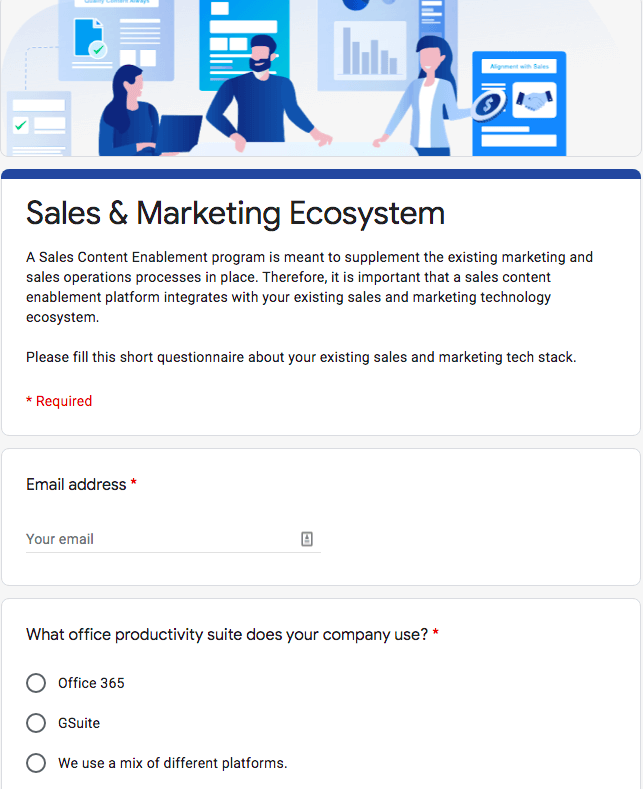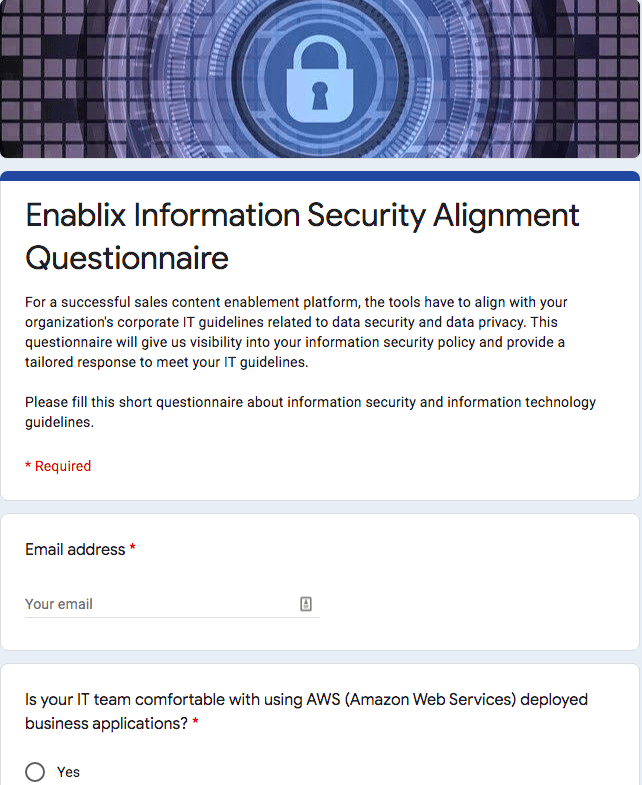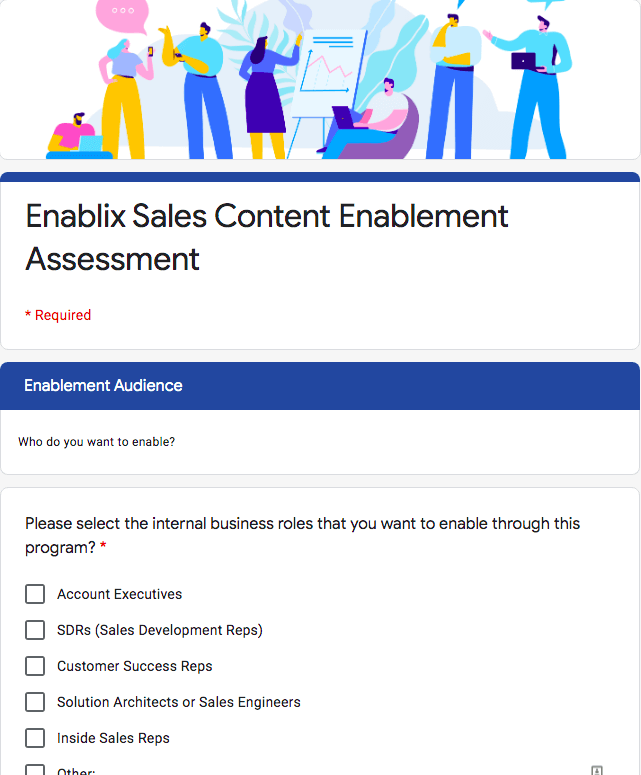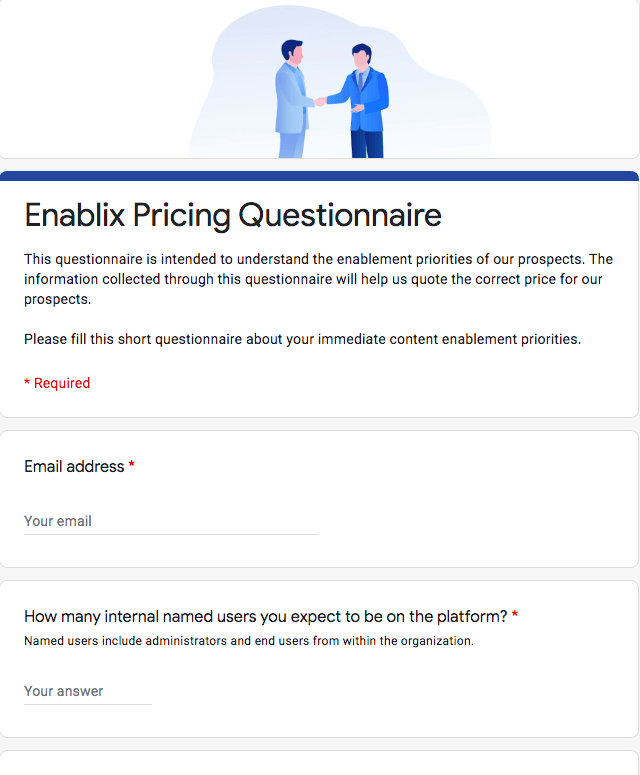Buyer Enablement
In today’s B2B sales environment, gaining insights into buyer’s priorities and pains is gold. These insights can make a material difference to the quality of guidance a seller offers a buyer and that quality ultimately drives the outcome of the buyer enablement process.
Organizations are increasingly investing in personalizing their content to their buyers. The more personalized and targeted content you share with your buyers, the more likely they will see you as a trusted advisor.
However, offering this personalized experience is challenging. Organizations are guiding their website visitors to relevant content by either offering them intuitive choices to drill into or by asking them targeted questions through landing page forms.
Still, there is a limit to the degree of personalized content you can offer to your buyers on your website.
Once you have a qualified lead and you are engaged with the buyer, the possibilities to share targeted information are endless.
Holding discovery sessions and walking through a proper discovery is a well-understood sales process discipline. A well-conducted discovery helps you qualify better and also gives you the necessary context to better nurture and enable your buyer.
But it is difficult to get your prospect on the phone for a proper discovery. In fact, though a buyer is engaged and qualified, they are not willing to give you their time unless they see value from you.
With everyone getting busier and with the advent of online communications, there is a more efficient and better way to understand your buyer’s context.
In this blog post, we discuss how using online questionnaires can help you learn more about your buyer’s priorities and in turn better enable them and, eventually, win their business.
We also discuss several use cases where questionnaires can be highly effective in buyer enablement.
Benefits Of Using Online Forms
The obvious benefit of using an online questionnaire is to get insights into your buyer’s context so that you can serve them with the right information and eventually win the business.
However, there are other operational benefits of using an online questionnaire during the sales process.
Buyer More Likely To Share Information
There is no doubt that having a one-on-one conversation either in person or over the phone is the best way to conduct discovery.
However, trying to schedule a discovery in this format requires a time commitment from you and your buyer. Sharing an online questionnaire is not only more efficient, but it also is a much smaller time commitment on the part of your buyer.
Buyer can share their inputs on their time making it less demanding on their already busy schedule.
And by sharing the questions out in front (and having multiple choice answers for those questions), you have in turn made it easy for the buyer to fill out the form.
They don’t have to spend mental cycles describing their issues if you have already encoded the usual challenges in your questionnaires.
Opportunity to Demonstrate Expertise
Buyer assessment questionnaires should be about the buyer’s pain points, challenges, and business priorities.
But if you come up with the right questions, you have an opportunity to demonstrate the knowledge and expertise within your organizations.
You must have come across the commonly used phrase in an interview or Q&A format
“That’s A Very Good Question.”
This is the responder praising the person who asked the question. You want to create the same experience with your online questionnaires and assessments.
But now you have an opportunity to take this construct one step further. By offering choice options for some of your questions, you can demonstrate expertise.
Let’s use an example:
Being a content enablement platform, we usually ask our buyers the following question:
Does the marketing team struggle to manage content for any of these use cases?
- Sales Kickoffs
- Product Launches
- Learning Kits
- Other
When a buyer reads this question, they are curious and intrigued. By asking this question we are talking about their pain points and also building curiosity about how Enablix can help them with these use cases.
Live format is definitely a preferred choice of conducting a buyer-interview. However, an online asynchronous format gives you more space to ask for several details without the pressure of time.
Easier To Track And Measure
When you use online assessments to capture your buyer discovery and buyer assessment process, it helps deliver valuable insights.
- Measure the adoption of these questionnaires across the sales team.
- Track the responses to these questionnaire forms and use this data to refine your questionnaire.
- Report on completion rates of these questionnaires and assessments.
- Content creators can learn from the buyer’s responses and make informed future investments
- A properly completed questionnaire informs you about the buyer’s intent.
Standardize And Scale
Online questionnaires make it easy to standardize and scale the discovery and buyer assessment process. Organizations are already focused on creating personalized experiences for their buyers.
The same principles apply to these questionnaires. The challenges and priorities of a Fortune 500 CIO are different than that of a mid-market enterprise’s CIO.
Online questionnaires make it easier for enablers to standardize the discovery and assessment process based on different classes of the buyer.
Here are the ways you can classify your questionnaires and assessments to add more context and make it easier to target the right buyers.
- Buyer Persona
- Industry
- Solution
- Market Tier
- Geography
Easy To Integrate With Your Sales Applications
Digital online questionnaires are easier to integrate with existing sales applications like CRM systems. By making them part of the sales reps existing workflow, you increase adoption and drive engagement.
Plus with additional technical work, you can tie the insights you gain from these online assessments with your sales pipeline stages.
This attribution will give your organization further insights into the correlation between your sales pipeline and buyer responses. These insights can be used to better coach your sales team and further improve your questionnaires.
Use Cases for Online Questionnaires
Here are some of the sales process use cases that lend themselves very well to the use of online questionnaires and assessments.
Discovery Questions
A good discovery is crucial for any sales opportunity. If done right, it can provide valuable information about the buyer’s priorities.
It presents an opportunity to establish credibility with the buyer. When a buyer requests a demo, you want to first learn about the buyer before you dive into the demo.
An online questionnaire can be a great way to learn about your buyer’s context before the scheduled demo event. This will give you the information to tailor your demo and your presentation to the buyer’s pain points.
If your reps cannot share the discovery questionnaire beforehand, they can always use it internally to make sure they ask and record all the information when they are on the call.
Given our focus on sales content enablement, it is important that we align with our prospect’s existing sales and marketing ecosystem. To help drive this alignment, we use the below Sales & Marketing Ecosystem discovery questionnaire to understand our prospect’s existing investments.
IT Assessments
Helping your buyer build internal consensus with other decision-makers is a big part of the buyer enablement process. And in today’s digital age, it is common to see IT (Information Technology) teams having a seat at the table.
Alignment with an organization’s IT infrastructure is very important to help your champion build the case for your offering.
Given the importance of IT alignment, reps should get ahead of the process and conduct IT assessments to determine a fit.
Furthermore, when you determine an IT fit, you stand out from your competitors in your buyer’s selection process. You are indirectly telling the buyer that selecting your offering will not cause any IT misalignment.
This is very useful for the buyer and you. And in the scenario where there is NO fit, it saves you and your buyer valuable time.
Here is an Information Security Questionnaire that we use to determine IT fit with our prospects.
Business Case Assessments
Building a business case is an important part of the majority of the buying processes. It rarely happens that an organization purchases a product or a service without understanding the intended value of the purchase.
Buyers are interested in building a business case to build internal consensus and to defend the cost of the purchase.
Sellers are in a unique position to help buyers build these business cases. From their experience with other similar buyers, they know the value statement. Many organizations have online calculators that will help you with building the ROI (return on investment) math.
If you have a more complex value proposition that cannot be captured in an online calculator, you can use business case assessment forms.
Here is an Enablix Sales Content Enablement Assessment questionnaire that we use to help recommend best practices to our buyers.
Pricing Assessments
In the B2B world, pricing can be tricky. Organizations continue to tweak with different pricing models to price their offerings.
It is common for businesses to have complex pricing calculations to determine the total cost of a project. Pricing Assessment forms can be very useful to get the necessary inputs to calculate the target pricing for the buyer.
Here is a pricing assessment form that we use at Enablix.








